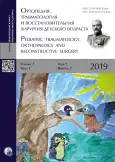Оценка результатов функционального протезирования детей с врожденными дефектами кисти и пальцев
- Авторы: Круглов А.В.1,2, Шведовченко И.В.3
-
Учреждения:
- ООО Северо-Западный научно-практический центр реабилитации и протезирования «Ортетика»
- ООО «Сколиолоджик.ру»
- ФГБУ «Федеральный научный центр реабилитации инвалидов им. Г.А. Альбрехта» Минтруда России
- Выпуск: Том 7, № 2 (2019)
- Страницы: 33-40
- Раздел: Оригинальные исследования
- URL: https://bakhtiniada.ru/turner/article/view/11277
- DOI: https://doi.org/10.17816/PTORS7233-40
- ID: 11277
Цитировать
Аннотация
Обоснование. Оценка результата функционального протезирования пациентов с дефектами верхних конечностей является актуальной проблемой современного протезирования. Несмотря на развитие технологий бюджетного прототипирования и мелкосерийного производства, снабжение пациентов с беспалыми культями кисти функциональными протезами не приобрело массового характера и относится к атипичному и экспериментальному протезированию. На фоне появления новых вариантов функциональных протезов кисти отсутствует алгоритм оценки результатов протезирования.
Цель — оценить результат функционального протезирования детей с врожденными дефектами кисти и пальцев активными протезами.
Материалы и методы. Под наблюдением находились 67 детей, имеющих врожденные дефекты кисти, из которых в группу экспериментального протезирования включены 22 ребенка. Для объективной оценки остаточной функции кисти был разработан стенд, который имитирует задания международного соревнования пользователей техническими средствами реабилитации по кибатлону (Cybathlon) и позволяет выполнять пробы, за каждую из которых начисляется определенное количество баллов. Пробы на стенде дополнены субъективной оценкой функции кисти методом анкетирования по валидизированному в России опроснику DASH. Анкетирование проводили три раза на разных этапах: до протезирования, после обучения пользованию протезом и спустя 6 мес. после начала использования.
Результаты. Наилучшая субъективная оценка эффективности снабжения активным протезом кисти отмечена у пациентов с врожденными дефектами кисти, аналогичными усечениям кисти проксимальнее пястно-фаланговых суставов. Эти дети показали удовлетворительные результаты и на стенде. Самый низкий результат функциональности активного протеза кисти получен в случаях эктродактилии и гипоплазии I–V пальцев, что связано с высокой остаточной функциональностью кисти.
Заключение. Разработанный стенд является диагностическим, так как позволяет оценивать результаты функционального протезирования у пациентов с различными уровнями дефектов верхних конечностей, в том числе и дефектов на уровне кисти и пальцев, а также выполняет учебно-тренировочные функции. Он может быть использован для обучения пользованию активным протезом, а также для тренировки навыков с целью успешного прохождения трассы кибатлона или его отечественного аналога — кибатлетики. Результаты исследования на стенде коррелируют с результатами по опроснику DASH.
Ключевые слова
Полный текст
Открыть статью на сайте журналаОб авторах
Антон Вячеславович Круглов
ООО Северо-Западный научно-практический центр реабилитации и протезирования «Ортетика»; ООО «Сколиолоджик.ру»
Автор, ответственный за переписку.
Email: kruglov@scoliologic.ru
ORCID iD: 0000-0002-3811-5773
SPIN-код: 3312-5350
https://www.instagram.com/kruglov_scoliologic/
врач травматолог-ортопед; руководитель отдела перспективных технологий
Россия, 195253, г. Санкт-Петербург, ул. Стасовой, д.1, лит. БИгорь Владимирович Шведовченко
ФГБУ «Федеральный научный центр реабилитации инвалидов им. Г.А. Альбрехта» Минтруда России
Email: schwed.i@mail.ru
ORCID iD: 0000-0003-4618-328X
SPIN-код: 3326-0488
д-р мед. наук, профессор, научный руководитель
Россия, 195067, г. Санкт-Петербург, ул. Бестужевская, д.50Список литературы
- Xu K, Liu H, Zhang Z, Zhu X. Wrist-powered partial hand prosthesis using a continuum whiffle tree mechanism: A case study. IEEE Trans Neural Syst Rehabil Eng. 2018;26(3):609-618. https://doi.org/10.1109/TNSRE.2018.2800162.
- Ibrahim AM, Jose RR, Rabie AN, et al. Three-dimensional printing in developing countries. Plast Reconstr Surg Glob Open. 2015;3(7):e443. https://doi.org/10.1097/GOX.0000000000000298.
- Hoy MB. 3D printing: making things at the library. Med Ref Serv Q. 2013;32(1):94-99. https://doi.org/10.1080/02763869.2013.749139.
- Gerstle TL, Ibrahim AM, Kim PS, et al. A plastic surgery application in evolution: three-dimensional printing. Plast Reconstr Surg. 2014;133(2):446-451. https://doi.org/10.1097/01.prs.0000436844.92623.d3.
- Агейкин А.В. 3D-моделировaние и 3D-принтинг как новый этап в развитии сосудистого протезирования // Огарев-Online. – 2017. – № 7. – С. 3. [Ageykin AV. 3D modeling and 3D printing as a new stage in the development of vascular prosthetics. Ogarev-online. 2017;(7):3. (In Russ.)]
- Zuniga J, Katsavelis D, Peck J, et al. Cyborg beast: a low-cost 3D-printed prosthetic hand for children with upper-limb differences. BMC Res Notes. 2015;8:10. https://doi.org/10.1186/s13104-015-0971-9.
- thingiverse.com [Internet]. Zuniga JM. Cyborg Beast [cited 2019 May 20]. Available from: http://www.thingiverse.com/thing:261462.
- Руководство по протезированию и ортезированию / Под ред. М.А. Дымочки, А.И. Суховеровой, Б.Г. Спивака. – 3-е изд. – М., 2016. [Rukovodstvo po protezirovaniyu i ortezirovaniyu. Ed. by M.A. Dyimochka, A.I. Suhoverova, B.G. Spivak. 3rd ed. Moscow; 2016. (In Russ.)]
- Физическая и реабилитационная медицина: национальное руководство / Под ред. Г.Н. Пономаренко. – М.: ГЭОТАР-Медиа, 2016. [Fizicheskaya i reabilitatsionnaya meditsina: natsional’noe rukovodstvo. Ed. by G.N. Ponomarenko. Moscow: GEOTAR-Media; 2016. (In Russ.)
- Gordon AM, Magill RA. Motor learning: Application of principles to pediatric rehabilitation. In: Physical therapy for children. Ed. by S.K. Campbell. 3rd ed. Philadelphia: Saunders; 2011. P. 157.
- bbc.com [Internet]. Lewington L. Cybathlon: Battle of the bionic athletes [cited 2019 May 20]. Available from: http://www.bbc.com/news/technology-37605984.
Дополнительные файлы











